Hey Guys,
Mel again from Cooper and Kids.
Firstly, I hope you are all keeping healthy and safe and being kind to one another during this time of uncertainty. This is an exciting topic for me, one we have decided to share earlier than anticipated with you all, given what’s going on in the world with COVID-19. As lots of you might be self-isolating, enrichment is a great way to keep your dog mentally stimulated without going out.
What is Enrichment?
Ok, let me get straight into it. In simple terms, enrichment is literally anything we can do to make our animals life more interesting. In more specific terms, enrichment is intended to promote behaviours that are appropriate, instinctive or “normal” for that species, and fulfil an animal’s physical and psychological needs.
Why is Enrichment important?
"When an animal is under human care, we have removed an exquisitely adapted organism from the environment that shaped it over countless years. Stimulating their minds and activity levels allows us, in some small way, to give them back what has been lost in this transition." - Chris Jenkins CPBT-KA**
Enrichment provides mental stimulation and therefore prevents behavioural difficulties and improves the overall quality of life for our dogs. We must think about what they would be doing in their natural habitat and what we can do to mirror that. Enrichment can help to create a positive welfare state for all animals and is so important for behavioural health (especially for animals kept in zoos, aquariums etc). It can help to decrease stress in animals.
When is Enrichment important?
In general, it would be fantastic to use enrichment on a daily basis, but to be honest, you probably don’t even realise that you are already providing some form of enrichment for your dog every day. It’s fantastic to use when you can’t leave the house, due to extreme weather, or if you are sick, injured, etc. It’s also important for reactive dogs that just can’t get outside. It’s great for owners who work long hours as it can help fill that 8-9-hour gap when you’re not home. As mentioned above it can really help if a dog has behavioural issues as it’s going to help decrease boredom. Enrichment is mentally stimulating and will tire them out more.
Five types of Enrichment and examples
Every dog is an individual, there are different breeds and different temperaments. The type of enrichment a pug has will most likely be different to a border collie. So, we must come up with a tailored enrichment plan appropriate for your dog’s size, age, health condition and breed specific behaviours.
1. Social Enrichment
Social enrichment is about letting your dog interact with other people or animals. A simple trip to your mum’s house, can be social enrichment for your dog because they get to engage in people that aren’t just living in your house. If your dog doesn’t like dog parks but loves your cousins’ dog, make sure to nurture that and make regular play dates. If your dog loves people, let him interact with people. It doesn’t just need to be other dogs. It could be any species like cats, bunnies, birds, ducks (just be careful and keep your dog on lead at first if you’re not sure how they will respond). Social enrichment can also mean training or games with you, like a game of tug-of-war or fetch. My kids love doing running races in the house and our dog will often join in. That’s a form of enrichment!
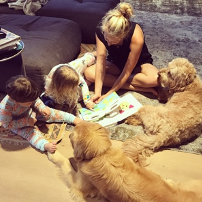
2. Cognitive Enrichment
This can include things like puzzles, training, those things that are mentally stimulating and going to get your dog thinking. Yes, they may involve food too but it’s more about getting the dogs brain working. Something as simple as popping treats in a muffin tin and covering them with a towel or a tissue. Watch your dog try to work out how to move it to get to the treat. A game of hide and seek can be great fun. My dog, Cooper loves it when we hide his toys or treats around the house and make him go find them. This is a good one for the whole family to get involved in. The kids love hiding his things and watching him try find them. It’s a great mentally stimulating game for your dog. We’ve even taught him how to differentiate between certain toys.
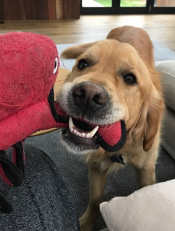
3. Physical habitat Enrichment
We can add something to their environment to redirect the undesirable behaviours or to just help foster some of their breed specific traits. Let’s think about a dog who loves to dig. We could perhaps give them a designated area to dig in, i.e. a clamshell full of sand. We would draw them to it by burying its favourite toys or treats. Or for my dog, he loves the water, so on a hot day, I fill up the clamshell with water and let him play in that.
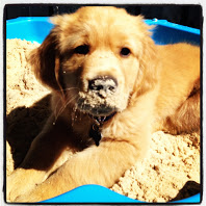
4. Sensory Enrichment
Sensory enrichment refers to engaging your dog in anything that involves any of their sensors. Dogs love new smells and they need to use their noses. They even like to see new things. Taking them to new places, the café, a friend’s house, the beach, on a hike, there are so many fun things we can do. This is why it’s important to not go on the same walk every day. Mix it up for both you and your dog. Take them on new and exciting adventures. Let them stop and sniff. It’s so important for them. Often taking your dog on a long slow walk and letting them sniff, will be more exhausting for them than a quick run around with another dog at a dog park. Some dogs even like to watch tv or have the radio on when their owners go out.
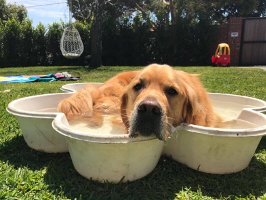
5. Food Enrichment
Did you know that you don’t actually need to feed our dogs in a regular bowl? We can get creative and use enrichment to feed them. There are so many options out there from puzzle bowls, licky-mats, peanut butter in a kong, kong wobblers, to snuffle mats, the list goes on. Make sure to plan your enrichment ahead of time as it’s important to create a good variety for your dog. And to make it the night before if it’s something you want to freeze for them. I usually freeze Cooper’s licky-mat if I’m organised enough, I use plain yoghurt and banana and he loves it. Licking can be quite calming for a dog.
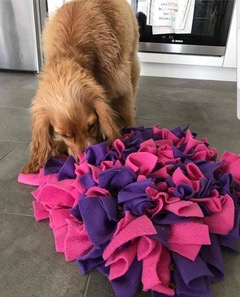
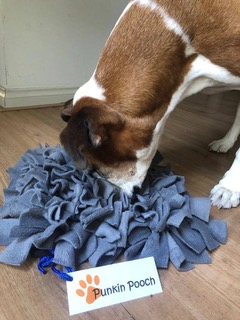
"Punkin Patch make these gorgeous handmade snufflemats using new and recycled materials. 100% of profits are donated to English Cocker Spaniels Australia Inc (ECSA) rescue organisation head to their instagram or facebook to find out more.
Just remember that enrichment doesn’t always need to be food. Dogs have other needs that need to be met, all of which we just mentioned above. You also don’t need to go out and spend lots of money on enrichment toys. You can use recyclable things too. Yoghurt tubs, egg cartons, cardboard box, muffin tin, etc.
The Facebook group "Canine Enrichment" is a group where people share ideas (using photos or videos) of enrichment ideas you can try.
Not all dogs love other dogs, not all dogs love other people. Some love tug-of-war and some love cuddles. Find what/who your dog loves and go with it. But make to give them variety in their lives. Get them excited. Mix up their days and their lives so they enjoy it. Find what your dog loves most and just go with it.
Mel xox
**"What is Animal Enrichment?" Nashville Zoo at Grassmere. March 15 2016. https://www.nashvillezoo.org/our-blog/posts/what-is-animal-enrichment
Mel Ritterman is a qualified dog trainer and mum-of-three. You can find more information about Mel on her website Cooper and Kids, or follow her on Instagram or Facebook. If you have a question for Mel feel free to email her at mel@cooperandkids.com.
Disclaimer: Dogshare and Mel Ritterman will not be liable for anything that happens to you or your dog by following our advice and tips. If you have real concerns or worries about your dog, please seek out a professional vet or behaviourist to come and assess the situation.